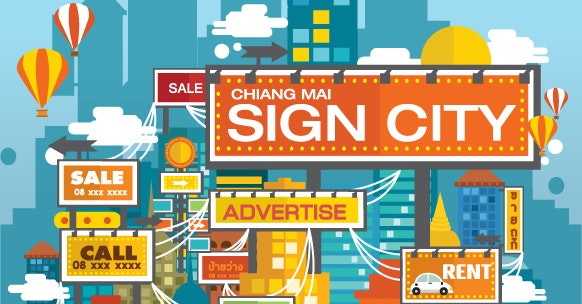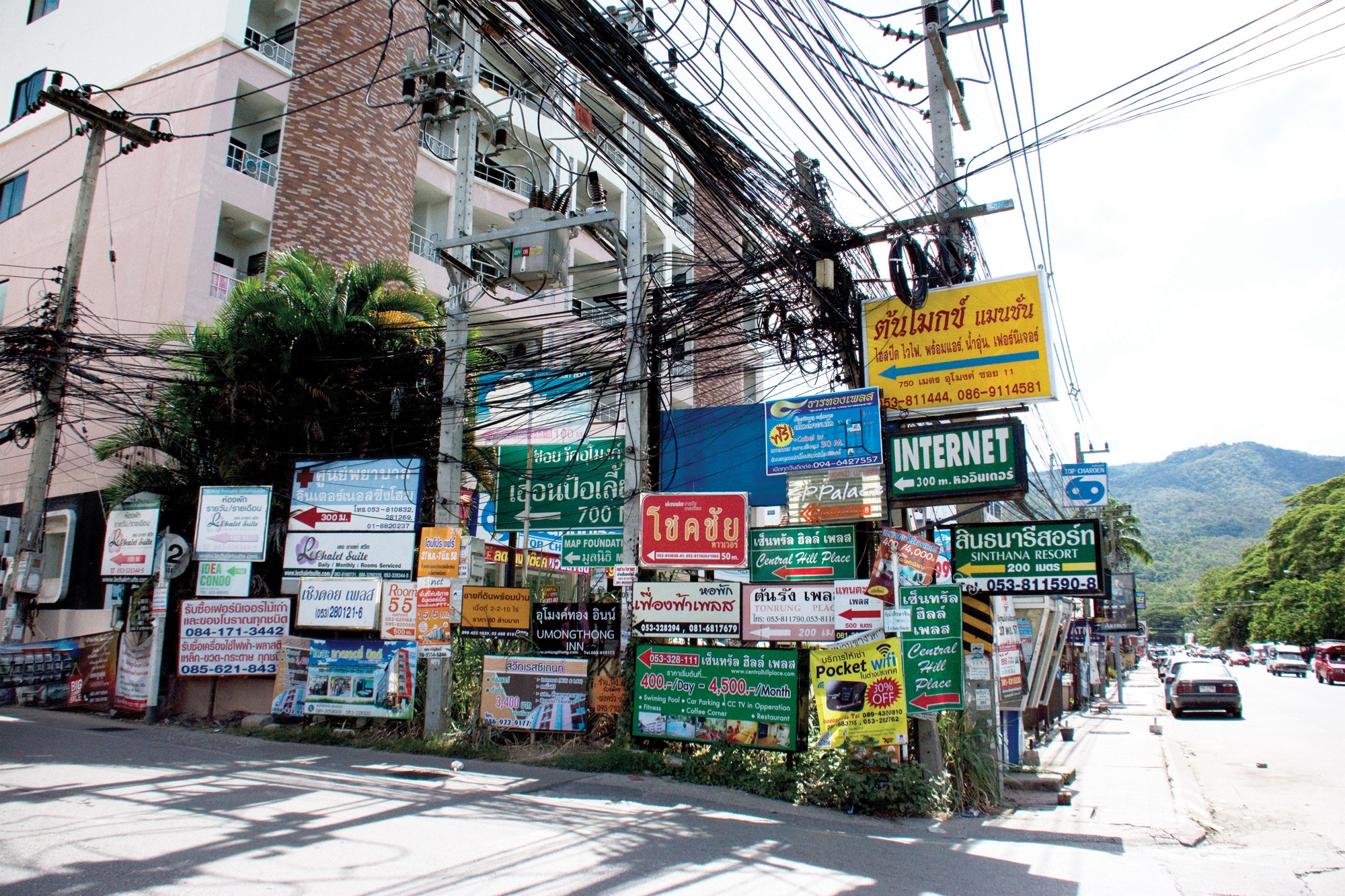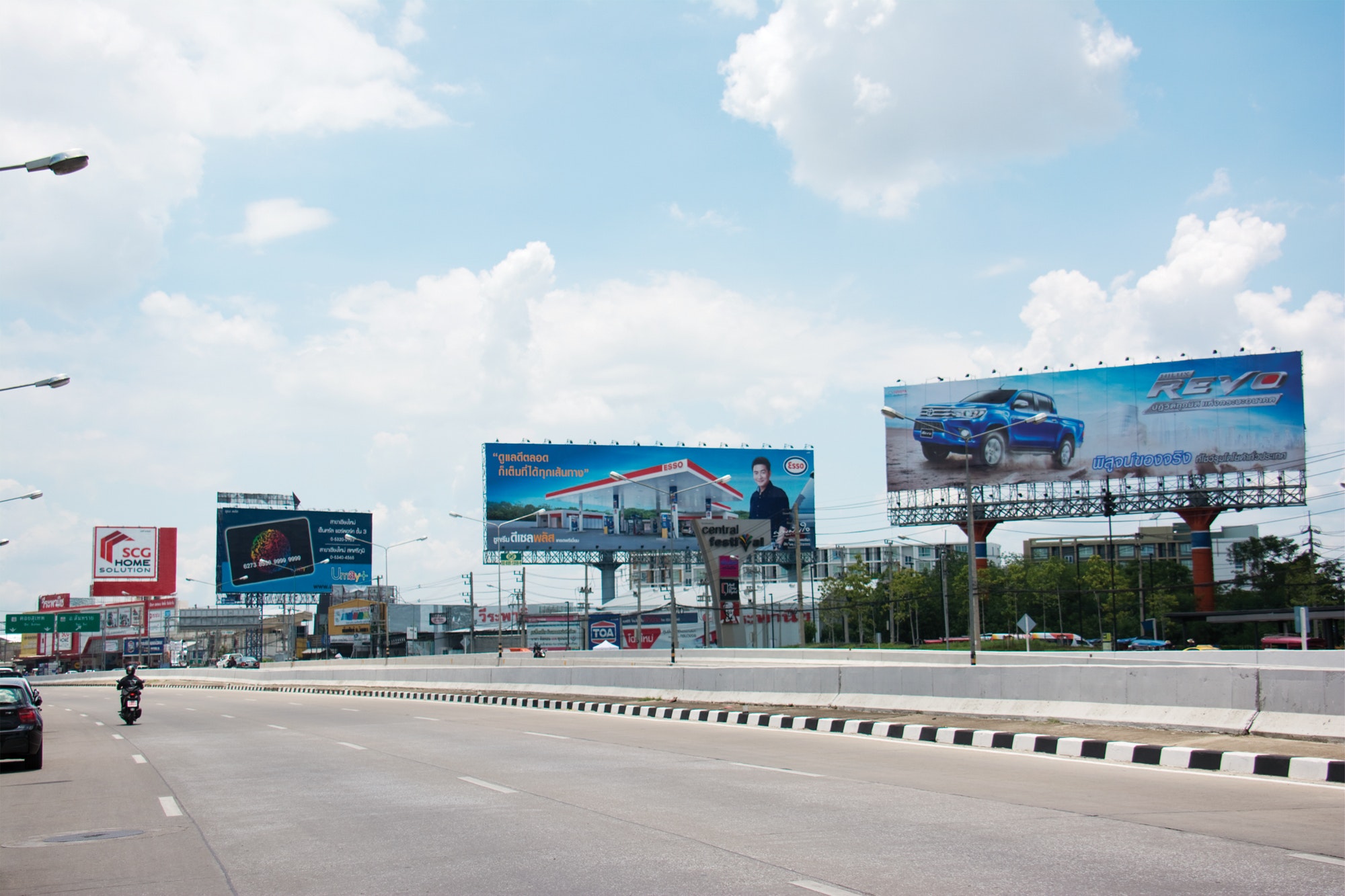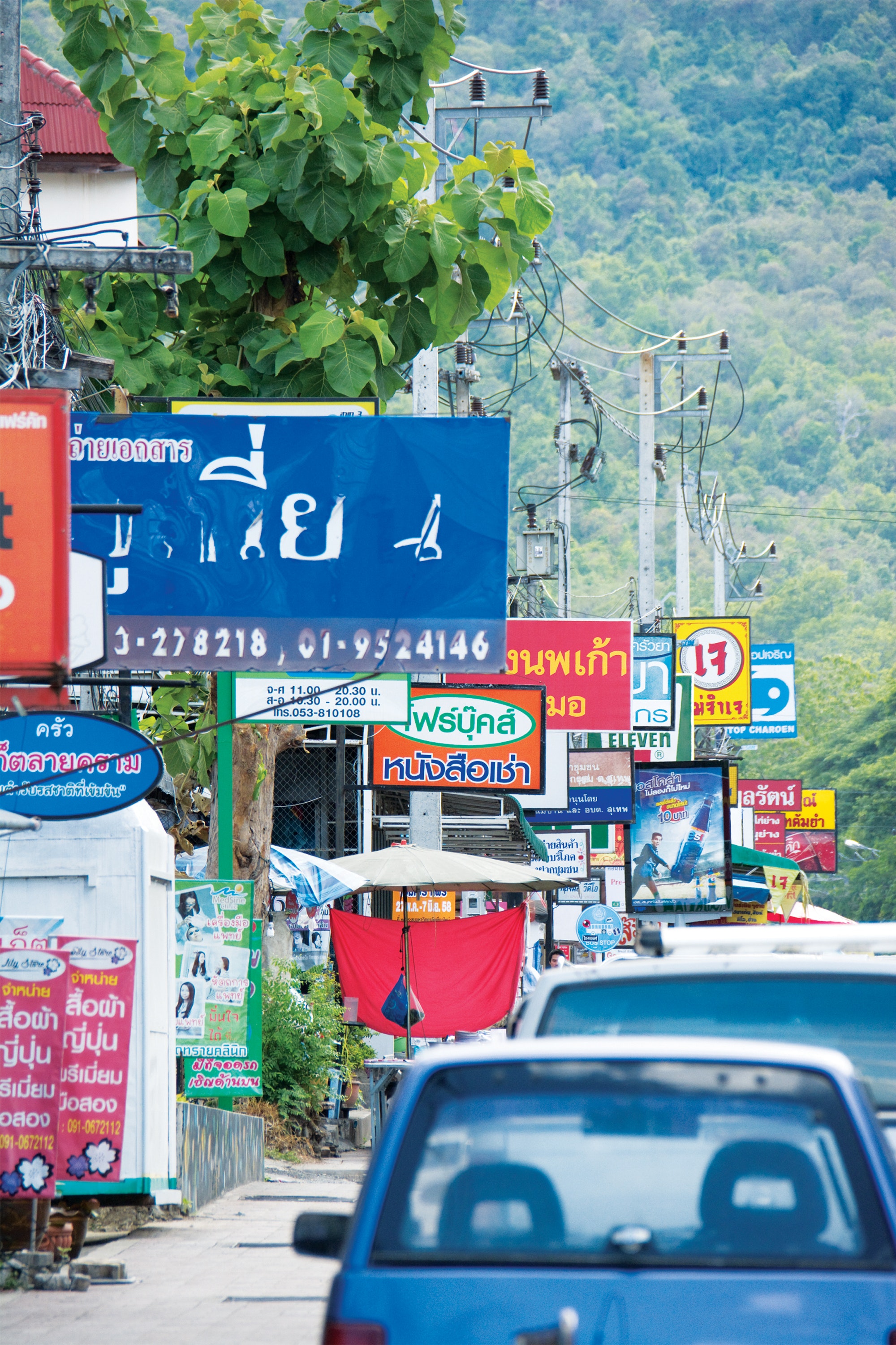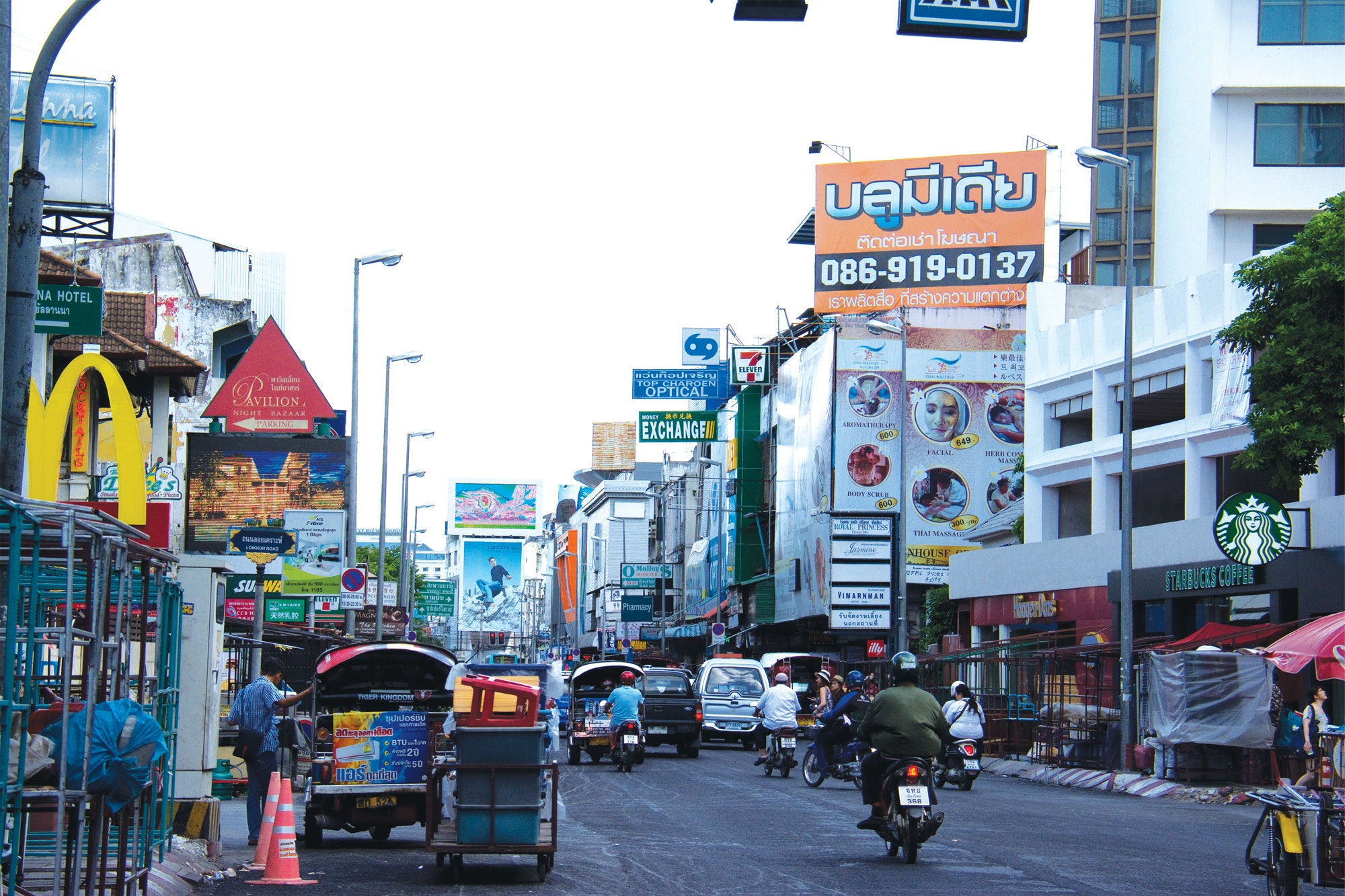ภาษาไทย คลิกที่นี่
Our moat is looking pretty, lined with beautiful trees which explode into vibrant hues every summer. The city’s gardener is doing a fine job setting up and maintaining flower beds in little pockets every where. The old city is being polished and shined, thanks to the many new rules and regulations being enforced such as height restrictions, design controls as well as colour palette guidelines. Good things are being done and in many cases the public money is being used wisely.
But what is the point of planting beautiful trees, setting up flower beds, renovating architecture and cleaning up the city if all of it is overshadowed, literally, by billboards?

Everywhere you look now you are inundated with advertising. From back-lit signs peddling snail slime to whiten your skin to giant billboards boasting new cars to clog up our streets… and send us all further into debt. Where once we could drive around the Superhighway and admire the skyline of Doi Suthep, today we see one giant four story billboard after another hawking their wares.
It’s a mess.
To try to put into context how out of control the proliferation of billboards has become, Citylife decided to attempt to count the number of advertisements found along Nimmanhaemin Road, Chang Klan Road’s Night Bazaar stretch and the Airport Plaza Intersection. This little exercise is in no way definitive, we ignored many of the smaller signs and posters and only concentrated on those we could see as we walked around. Here is the breakdown:
Nimmanhaemin Road from Rincome Junction to the intersection just past Warm Up (0.9 kms): On public property there were a total of 63 signs, 46 of which were commercial ads erected in the middle of the pavement and 17 of which were sign posts at the front of each soi advertising businesses within. On private property there were 581 advertisements with 188 signs attached to buildings (56 of which are LED), 196 on pavements (two LED), 10 billboards (two digital), 176 at guideposts in front of the sois and nine in construction areas. In total 649 advertisements to be seen as we walk along public pavements.
Chang Klan Road’s Night Bazaar stretch (0.85 kms): Forty signs in public areas with three LED signs on buildings and 37 on pavements. As to advertising on private property of the 294 signs, there were 195 on buildings (96 with LED), 82 on pavements, 15 billboards and two digital billboards. The grand total came to 334 visual advertisements.
Standing at the Airport Plaza Intersection: A total of 26 signs were on public spaces and 104 on private property with 27 on buildings, 44 on pavements, 31 billboards and two LED, and totalling 130 signs.
Of course not all areas of the city are so visually polluted, but these numbers are very alarming.
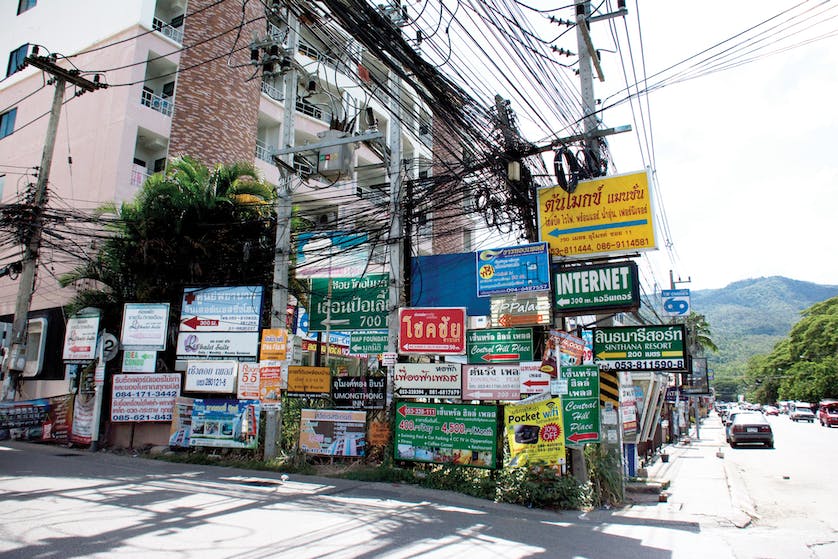
According to the sign board tax act of 1992, an updated version of the Maintain Cleanliness and Orderliness of the Country act of 1960, without consent from authorities, no signs may obstruct public spaces of any kind nor clutter and make unattractive buildings or public spaces by hanging, affixing or placing advertising of any kind onto them. Fines can be imposed and said signs removed.
The reality, however is that there are not only ways around it, but the authorities themselves are, if not causing, then compounding the problem.
“The municipality is the reasons there are signs cluttering our city,” said the owner of one of the six largest Chiang Mai sign companies who, along with some other people we talked to for this article, asked to remain anonymous. “The current mayor has overseen the most unprecedented rise in the amount of billboards and signs in our city’s history.”
“How it works,” he continued in his office next to his factory which churns out hundreds of signs a day, “is that if you want to put up an advertisement on your own property, whether it is your own product or you are renting your prime location to a sign company, you must abide by the rules. It is very simple though, like getting building permission, you just have to stay within height restrictions (same height as building restrictions), make sure the content of the ad is not breaking any laws such as those for alcohol or cigarette advertising, not allow the advertisement to become an impediment to public spaces, if it is a large sign that requires construction then you must get an architect to sign off on it and you are pretty much guaranteed permission from the municipality. The sign company will pay the tax for you, which is pretty minimal and you can just sit back and collect your rental fee.”
Sign taxes come in three levels, if the advertisement is in Thai it costs 3 baht per 500 square centimetres in tax per year, add a foreign language and you are now paying 20 baht per year and if you have foreign language only, or the Thai text is so small it is negligible, then you will be taxed 40 baht for the same space.
“What concerns me is this new spate of signs which are not on private property, but on public land,” he continued. “This is controlled by either the municipality, or in some cases by the Highway Department, but the vast majority is by the municipality. As far as I know, only three Bangkok based companies hold all the concessions for the thousands of public advertisements in Chiang Mai. No company I know here is involved. So let’s say a company from Bangkok comes up here and asks the municipality for a concession to place 100 billboards: they will pay a concession fee, be granted the rights to build sign posts or construct billboards for a contracted period of time, and then pay their taxes. I don’t know what other deals they have to make, but you should be able to get the audited accounts from the mayor’s office.”
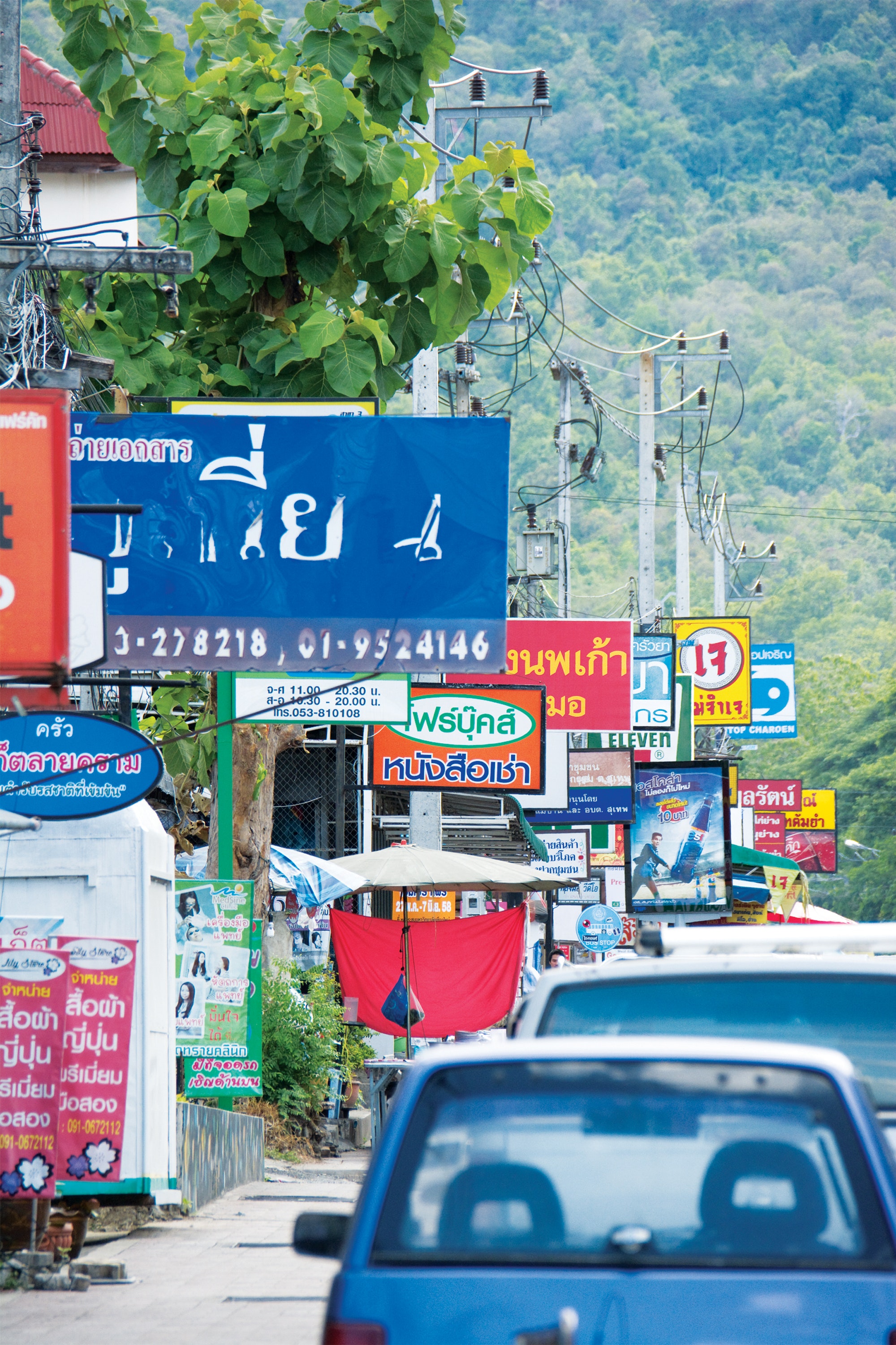
“I pay hundreds of thousands of baht per year for all my clients’ tax to the municipality,” the owner of the sign company continued. “I currently have 30 properties with whom I have negotiated contracts with for my clients. But I have never negotiated with the authorities for public space. In the past, companies from Bangkok would ‘donate’ garbage bins, bus shelters or police boxes in return for a relatively subtle logo or small ad. Today it’s shameless, they can advertise anywhere. As a local man, I understand, respect and love Chiang Mai, so I know that large billboards are actually not that effective because Chiang Mai people don’t like them. In fact there have been instances when people have protested against them; there was a sexy ad for a famous bra brand set against the backdrop of Doi Suthep that was protested down, and the latest outrage is over the massive digital screens recently erected on Tha Pae Road in front of the Tourist Information Centre.”
He is referring to the duo of digital screens currently causing quite an uproar not only in the media, but on social media. A Bangkok based company has signed a three year contract with the mayor to erect these massive screens, and in return 30% of its digital displays will be used for public announcements. There has been no mention of any income to the city from this concession, though we assume that regular signage taxes apply (there are no distinctions in the tax law regarding digital or LED advertisements as yet).
“We have recently installed over 80 CCTV cameras throughout the city. There is no point in having CCTV cameras if people don’t know about them,” Mayor Tassanai Buranupakorn told Citylife. “Studies show that up to 70% of crime can be reduced by this system. The large digital screens displaying live feeds from these cameras are a free way for us to make people aware of the cameras in the hopes of preventing crimes. The screens will also be used to make public announcements such as live broadcasts of Loy Krathong or anti-burning notices during the hot months. Initially we were going to put them up at Three Kings monument as well as Tha Pae Gate, but it would be better to have fewer of these, so we just picked this one location to minimise the clutter in the old city. We can always reconsider this concession once the contract expires.”
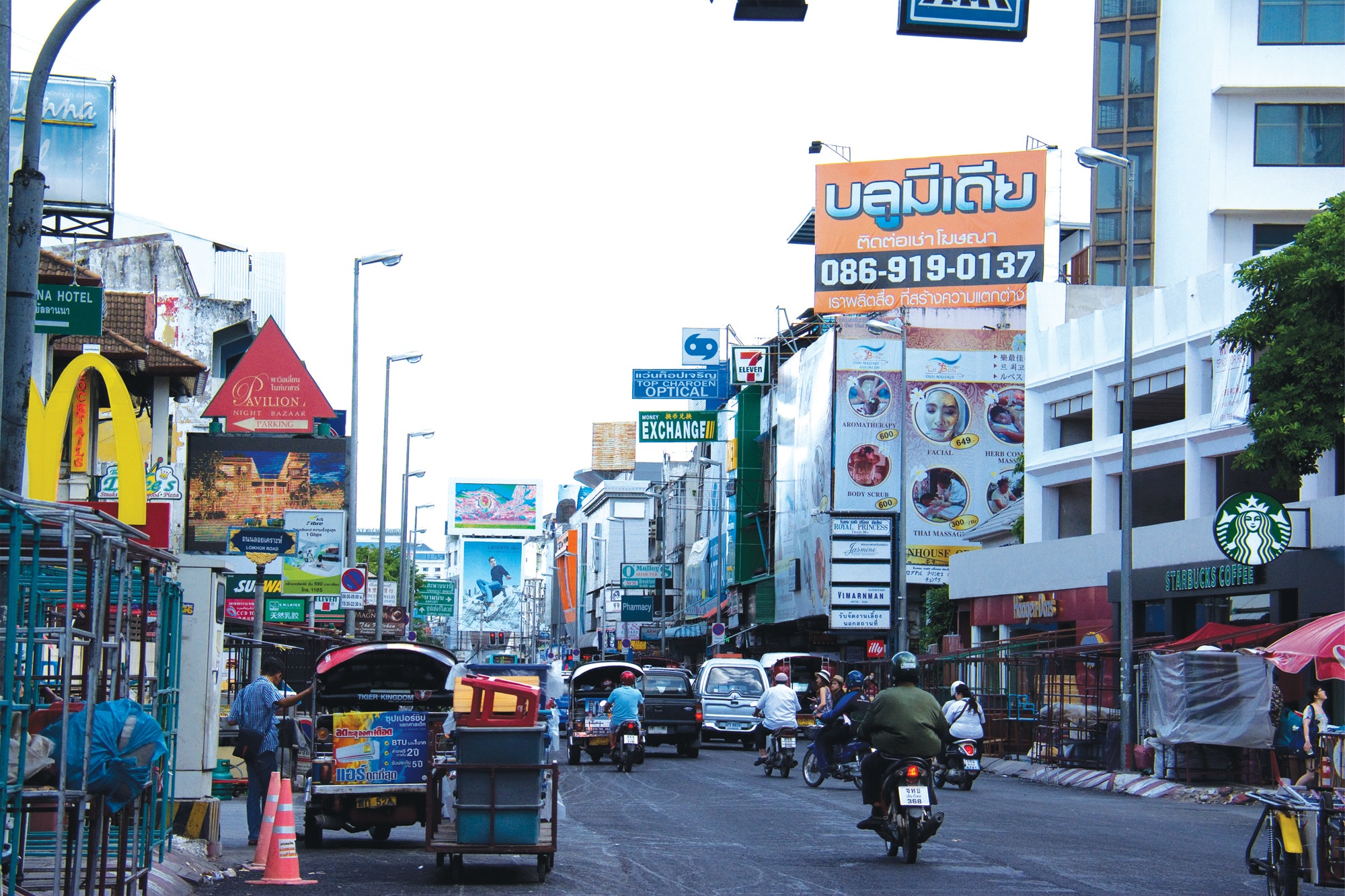
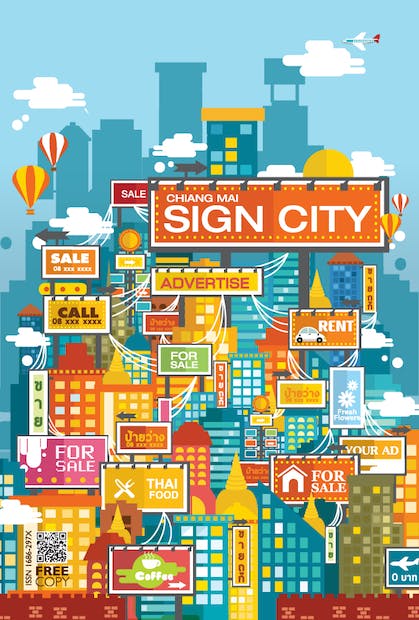
Architect Pawat Tantayanusorn, managing director of Niwat Architects agrees. “Some lovely buildings are completely covered in advertising; why do they even bother to hire architects?”
Pawat believes that Chiang Mai’s development, capitalism, investment as well as marketing have all followed the Bangkok format…to its detriment. “Ten years ago the first billboards arrived on the super highways. Today they are everywhere. There are no incentives, nor education or even understanding, for people to control this. It is easy money for people with property in locations coveted by signage companies. Chiang Mai is a special city. It has culture, history, architecture and nature. It should have its own set of laws that is different from Bangkok’s. In fact, the old city is already doing this, but Chiang Mai is more than just the old moat. The entire city should have controlled development.”
The mayor is ambivalent. “If you want to put a sign up on your property, I can’t stop you as long as you follow the rules. It takes years to change the law, I have changed some already and will continue to do so. We also need to think about businesses and we need Chiang Mai to grow and develop so that everyone benefits.”
Let’s talk numbers then. There is no definitive study as to the economic impact of signs, and certainly none here in Chiang Mai. But in 2006, San Paolo, Brazil’s populist and progressive mayor made the decision to ban all advertising in public spaces amidst much outcry from the business sector – 15,000 billboards were removed in a matter of months. Five years later many old buildings have been revealed to show a city with rich urban beauty and 70% of residents say that the ban has been beneficial and that there have been no noticeable economic repercussions. In the United States, Alaska, Hawaii, Maine and Vermont, all tourism states, have banned billboards completely. In fact, there are many cities around the world which have, if not outright banned advertising in public spaces, then at least set stringent measurements for control, and none appear to be the worse for wear by such decisions, on the contrary, many report increases in tourism revenues and citizen satisfaction.
Ex Bangkok governor Apirak Kosayodhin announced a similar measure, but focused on illegal advertising – posters, signs, banners, street cut-outs, all of which were deemed illegal – removing a whopping 776,408 signs from the greater Bangkok Metropolitan Area between 2009 and 2010. It seems that where there is a political will, there is always a way.
To see how our current mayor differs from past administrations, we gave our previous mayor, Dr. Duangtemdeun Na Chaing Mai (2007-2009) a call, to see what her policy regarding signs were during her tenure.
“Each politician has a different viewpoint and a different priority,” said the seasoned politician diplomatically. “Maybe the current mayor thinks it is more important to get money in from advertising. For many of us, we disagree. We think that the cityscape is more important. It is tangibly beneficial to Chiang Mai, as a tourist city, to have an attractive cityscape. I also wanted residents to have food for the eyes. I want to ask this administration to please listen to the public when it comes to these signs. When I was in office I didn’t sign one single signage concession. Not one. I had inherited some, but once their contracts expired, I didn’t renew them. You can’t control the whole city, but you can at least try.”
And of course these things should never boil down to just money. Phantawat Gungulsultorn, social activist and president of the Chiang Mai Musician, Singers, Actors Association was so outraged when he visited the Chiang Mai Blind School two years ago and learned of the numerous and repeated accidents blind children befall while navigating Chiang Mai’s pavements, he went straight to the top with his complaints.
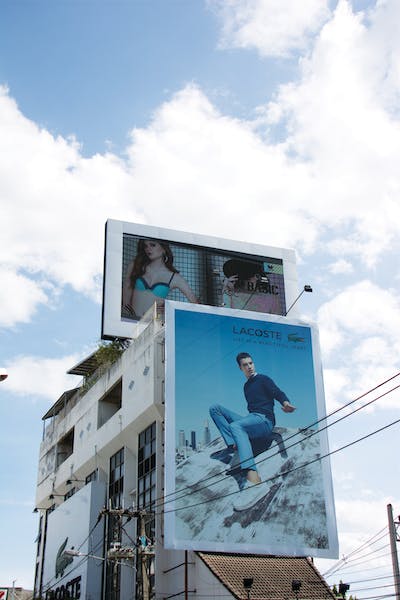
“It isn’t easy I agree, and, following pressure groups’ requests, the mayor has also made great strides in the old city,” said Tul Lekutai, President of Chiang Mai University’s Faculty of Architecture Alumni Association. “Building heights are now controlled, even roofs have to conform to the Lanna kalae design and only certain colours can be used for external paint. In fact, if property owners buy their own paint, the municipality will even provide labourers in support.”
“And it’s not just the municipality, the Highway Department is also guilty of this. They have no rights at all to sell signs…you know, those green signs with white lettering that are ubiquitous road signs throughout the Kingdom? Now you see The Harbor or the Night Safari signs erected to look like regular road signs; that’s just wrong.”
Pawat agrees that public pressure is bearing some results. “The top down management of Chiang Mai is slowly changing and this is a good thing. Before, the elected bodies, once elected, made decisions unilaterally and the public had little voice or recourse. An obstruction by someone in power would halt a movement in its tracks. Today, with social media and grass roots movements, we are seeing change being affected from the bottom up. Society is pushing for society’s interest. I suggest that we first use social and traditional media, then we ask members to make viral videos or record instances of signage abuse, adding catchy captions and create an agenda. We then set up workshops, hold competitions for new designs and host seminars. Get the academic sector involved. Get the sequences really lined up well and start slow. In this culture with so many groups involved, you can’t have your expectations set unrealistically. Goals must be reached or people will give up and walk away in frustration. Show that the economy will prosper with fewer signs, show that we can work towards a better designed and more creative city where information and businesses prosper while not eroding our cityscape. We need to all discuss this and come up with a shared vision of Chiang Mai. A realistic one. We want to be a cultural city but we also want to be progressive and modern, how do we reconcile these two agendas?”
“I would look at current concessions and their contacts. We can’t go back and negate them, but once we have a plan we need to give notice to all of them that their contracts won’t be renewed. Once they expire, we set new rules. New rules will control where and how many public spaces can be used for advertising. The authorities need to explain to us why it is in our best interest to sell these spaces. Can they? We should bring in sign makers, advertising firms, media associations, local businesses and all brainstorm on and off line. Air pollution, another issue I am using this format to fight against, is a few months a year, this visual pollution is year round.”
“We can’t expect instant results, this may have to be a 15 year project with a set target of reduction, but yes, we need to start. At this point there are no figures, no facts to support our suppositions, so let’s negotiate with strength, get the facts, get CMU involved and get some research done.”
According to Pawat, “the power holders are not using their powers for good, and that is Chiang Mai’s karma. We have to show the government our audited accounts every year, it is the least that we can expect from them to show us theirs. We need more groups in Chiang Mai, with everyone working towards a shared vision, but each focusing on another dimension, another problem, another agenda. Together we need to put a fire under the rear ends of authorities. You have now started this conversation about signage. I want to support this. Let’s get active.”
To that end, Citylife has set up a Facebook community page titled SignCityChiangMai where we will share, as we hope you will, photographs of signage pollution. If anyone has any suggestions or wish to get involved, we hope that you do so. We don’t expect to fix anything, but we wish to initiate a conversation and, with all of your help, slowly build up that little flicker into a flame to burn some serious bureaucratic bums.
